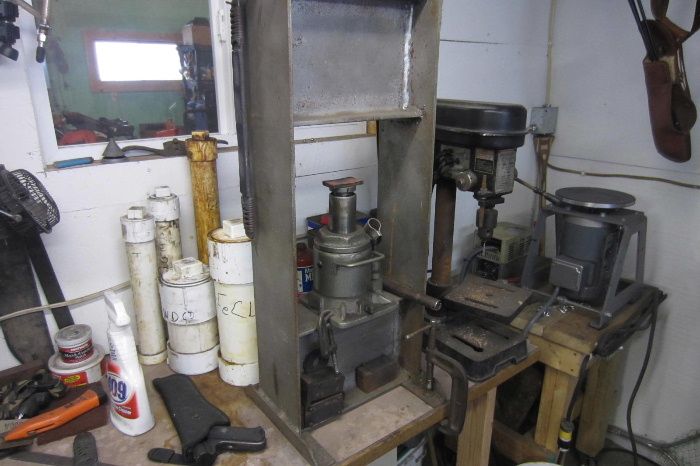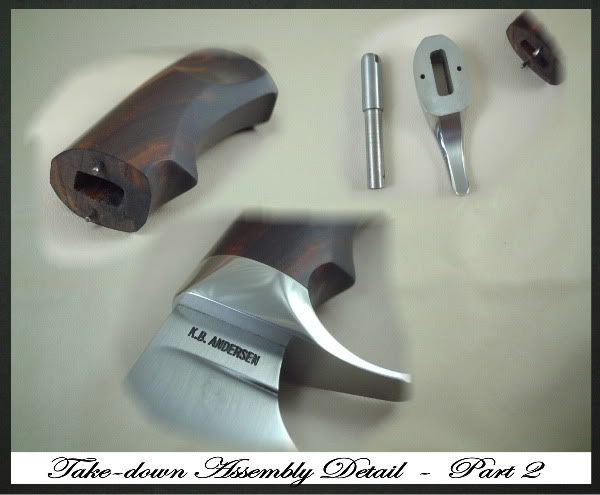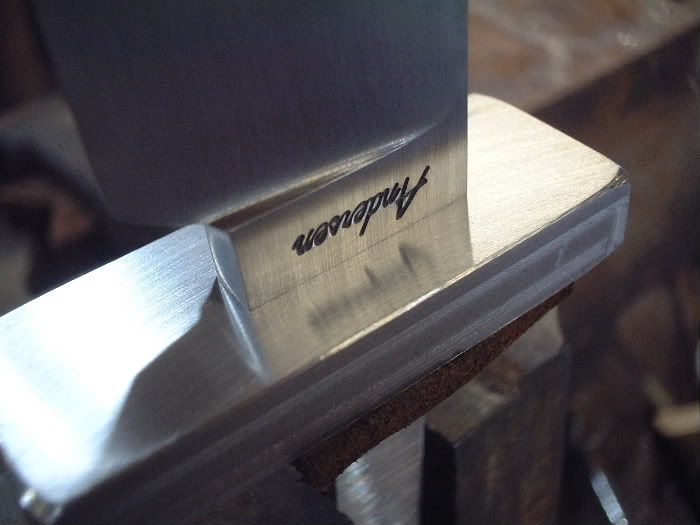This month's topic is a discussion of techniques for adding your name, or logo to your knife blade.
We've had some questions posted about stamping, vs. etching your logo. Which do you prefer and why? What is your process for stamping or etching? Where do you get your supplies for marking?
I use etching and diamond engraving. A few months ago I built an engraver. I got my stencils from Ernie at Blue Lighting in Florida. He is a very nice person, fast to deliver and very helpful. I etch when I need it now. If I have the time I send them out to my engraver.
I for one prefer "Old School" signing my knives with an engraver...The reason is that someone (that I have great respect for) once told me that it looked more hand made to him to see a signature on a blade than an etched name or logo. Which brings up a question--Does the way that a maker puts his/her name on a blade matter during judging as long as it is neatly done. I know that a pretty knife won't cut any better than an ugly one with the same geometry. Other than that reason I prefer a stamp which I have yet to aquire. The reason I prefer the stamp is the same reason I prefer the engraved name. The less cookie cutter the better. Just my opinion for what it is worth.
It's not that I prefer one method over the other, it's just that even this far into knife making, I still only use a stamp.
I do have three stamps of different sizes, so it helps from knife to knife.
I like the control I get with this set-up, in that, if the stamp is not deep enough to my liking, I can go back in and give it just a touch more "squeeze" until I'm satisfied. <img src=' http://www.americanbladesmith.com/ipboard/public/style_emoticons//rolleyes.gi f' class='bbc_emoticon' alt=':rolleyes:' />
Here's a press frame I made with a 50 ton jack and some I-beam pieces:

A couple holders for the stamps:

And in action:


Karl B. Andersen
Journeyman Smith
That's a slick set-up Karl!
You always keep a pistol in your work bench? LOL!!!
You can count on it!
|quoted:
You always keep a pistol in your work bench? LOL!!!
Karl B. Andersen
Journeyman Smith
You always keep a pistol in your work bench? LOL!!!
Doesn't everyone? <img src=' http://www.americanbladesmith.com/ipboard/public/style_emoticons//smile.gi f' class='bbc_emoticon' alt=':)' />
Personally, I use different methods for different knives. Blades that are thick enough get stamped, those that are too thin (and warp badly if stamped) get etched, and the majority of my folders have "Caffrey MS" engraved on the inside of the back spacer.
Regardless of the method used, I feel it is VERY IMPORTANT to keep it simple, and informative....meaning that THE KNIFEMAKER'S NAME needs to be in there. I also believe in staying away from obscure "logos" or using a "company name" as your mark. I can't count the number of times that an individual has come into my shop, with a knife that had some "touch mark", initials, or some weird etched logo, asking me if I knew who the maker was, so they could buy another knife from the person......if they can't find you, they certainly cannot purchase from you.
I have an article on my website about marking blades: http://www.caffreyknives.net/Makersmarkarticle.html
Ed Caffrey, ABS MS
"The Montana Bladesmith"
www.CaffreyKnives.net
I etch my mark. I tried stamping and it worked fine except for a bad experience with a damascus blade. So I went to etching. Right now it works well for me. I use a "personalizer" from Jantz and their etching solution which works on most ferrous metals. I make my own pads from lightweight felt from the fabric store. The stencils come from IMG in New York. I have used Ernie Grospitch's stencils and they work fine and are very reasonably priced. My mark is on file with IMG and it is easy to re-order when needed. If I were just starting on etching, I would probably go with Ernie. One thing to make sure that you do is clean the stencil after each use to remove the oxides. I use water and GENTLY rub the stencil, then hold up to light to make sure it is clean. I can see through it and no oxides remaining. Then gently blot dry. I get about ten to fifteen etches per stencil. I use very little etching solution on the pad and do three 30 second etches, blotting with a clean cloth between etching cycles. Then a cleaner which Jantz sells, which is probably a neutralizer also. Then a quick clean up with 600, 800, whatever my final sanding grit was on the mark. Make sure not to leave any solution on the blade, it can cause serious rust. One trick is to use cold bluing solution on the mark then re-sand the ricasso. The cold blue will stay in the mark and really make it stand out. I do this sometimes.
Karl, I like your set-up on the stamping, and the ruger on the bench. Also Ed makes a great point about your mark. Keep it simple and use your name. Makes you easy to locate. Luckily my name has a different spelling that no one uses except me. If someone does have the same name, you might consider also putting you state below your name. Also it looks better if you mark your name on the left hand side of the ricasso. This is considered the personal side of the knife, as opposed to the public side which faces outward. Just something someone told me long ago when I was just starting out.
One method I have seen used that I like a lot is EDM marking, or electrical discharge marking or machining. It gives you a very precise mark at a controlable depth. Unfortunately those machines are not cheap.
Brion
Brion Tomberlin
Anvil Top Custom Knives
ABS Mastersmith
I etch also; mostly. I still stamp primtives and living history projects. I wanted a continuation of my work;so my etch looks exactly like my stamp. There were knifemakers with my name before me so I just had my name logo made into an arc; which sets it apart from the others. IMG makes my stencils.
As Ed pointed out; a name is much easier to research than a snake track or a buffalo head. That way when someone digs up a really ugly knife two hundred years from now they can be sure it's mine.
I use a home built etcher, felt from the store, and I use two second bursts for 90 seconds for my etch. Then reverse polarity for 60 seconds to turn it black.
Etching allows me to mark anywhere on the knife; at anytime in the process. One bad stamping will pay for a nice etching set-up.
Brion; remind me at the hammer-in to pick your brain a little about this.
Mike
Mike Williams
Master Smith
Maybe "someone"? <img src=' http://www.americanbladesmith.com/ipboard/public/style_emoticons//wink.gi f' class='bbc_emoticon' alt=';)' /> could do an etching tutorial for our site?
Or even a couple people with a few different methods?
Karl B. Andersen
Journeyman Smith
Sounds like a good suggestion, Karl.
I have etched all of my blades, with different degrees of success.
I have a stamp, but chicken to use it without some means of keeping it straight and square with the ricasso.
Karl,I like the looks of your setup! Do you stamp the blade hot or cold?
Russell
|quoted:
Doesn't everyone? <img src=' http://www.americanbladesmith.com/ipboard/public/style_emoticons//smile.gi f' class='bbc_emoticon' alt=':)' />
Personally, I use different methods for different knives. Blades that are thick enough get stamped, those that are too thin (and warp badly if stamped) get etched, and the majority of my folders have "Caffrey MS" engraved on the inside of the back spacer.
Regardless of the method used, I feel it is VERY IMPORTANT to keep it simple, and informative....meaning that THE KNIFEMAKER'S NAME needs to be in there. I also believe in staying away from obscure "logos" or using a "company name" as your mark. I can't count the number of times that an individual has come into my shop, with a knife that had some "touch mark", initials, or some weird etched logo, asking me if I knew who the maker was, so they could buy another knife from the person......if they can't find you, they certainly cannot purchase from you.
I have an article on my website about marking blades: http://www.caffreyknives.net/Makersmarkarticle.html
Well put ED, and I also like to hot stamp my mark, and the holders for stamps work real well. Now I don't mean to get off topic here, and in a way this question does tie into this topic as most makers starting out face the same challenge, so here goes. Without the benefit of a surface grinder, press, or rolling mill, a forged blade, particularly one forged from non dimenssioned bar stock, ends up with a riccaso needing truing up. A stamp used in a holder will only give a proper immpresion if the riccaso is really square (on the flats), and holding the stamp by hand while hot stamping is not all that easy ( i do know this), so I'm wondering if you recommend a process for squaring up a riccaso for a good even stamp immpression? I myself will do this at the grinder and using a digital caliper, but I was wondering if others out there could offer advise on this. Wes
Edit: NM, made a decision.
|quoted:
........so I'm wondering if you recommend a process for squaring up a riccaso for a good even stamp immpression? I myself will do this at the grinder and using a digital caliper, but I was wondering if others out there could offer advise on this. Wes
You have a grinder with a flat ceramic platen?
Tell you what, I just dug though some older photos.
I see by this stamp that it was BEFORE I got my "Andersen" stamp which was in '07 I think, so that makes this knife six years old. Before I had either a disc sander or a surface grinder.
I used my flat platen and granite surface plates with sand paper.
This knife would have been my 5160 from 1" square stock.
Use a flatter on the anvil after forging to get both sides parallel.
Slow down. You can do it.

I also know that this particular knife was made in '09 - before a disc sander or surface grinder and was forged from 2" diameter W2.
Has a pretty good stamp, too. <img src=' http://www.americanbladesmith.com/ipboard/public/style_emoticons//tongue.gi f' class='bbc_emoticon' alt=':P' />

Just don't get in a hurry with most steps of knife making.
Karl B. Andersen
Journeyman Smith
You can count on it!
Doesn't everyone?
I've had some people wander into my shop that made me wish that I had a gun nearby! I have resolved that concern.
I etch my mark. I am currently using stencils from IMG. Ernie has sent me some stencils to try out.
I use an old Personalizer Plus machine. I do five or six cycles of about six seconds on DC. Then three or four six second cycles on AC. I have recently been using the deep etch pads from IMG. I am currently using an etchant solution that I bought from IMG.
What are you guys using for the etching solution?
I have seen, and have been told, all kinds of techniques for etching. Firm pressure on the pad, light pressure, short etch cycles, long cycles. Each technique with an explanation of how it is the CORRECT way to etch. All a bit confusing to me.
As Brion mentioned, it is very important for a good etch and also for the life of your stencils, to clean them after each use. I recently heard from another maker, that he puts his stencils in an little ultrasonic cleaner for a few minutes. I've got a couple of cheap little jewelry cleaners that I bought from Harbor Freight. I'm going to give this a try.

